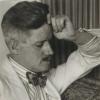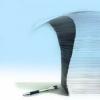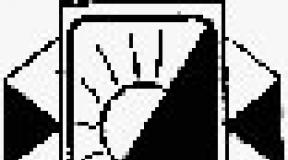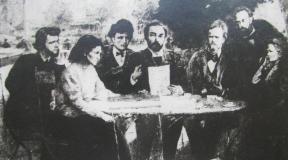Homemade antenna bandpass filter for a shortwave receiver. Building a homemade converter for an SDR receiver Homemade filter d 3 4 for the receiver
The filter has a short-wave bandwidth of 1.5 - 30 MHz and is used in the input circuit of professional short-wave receivers with a high (35-100 MHz) first intermediate frequency. Its task is to suppress the mirror and side reception channels, and thereby increase the noise immunity of the receiving path and reduce the local oscillator radiation into the antenna. It can also be used as an antenna bandpass filter to suppress industrial interference and interference from radio and television transmitters operating outside the shortwave range. This is convenient since its input and output impedance is 50 ohms.
In professional HF receivers, due to the use of a similar filter and the use of a high intermediate frequency, selectivity of combinational channels and IF above 100 dB are ensured. Using the example of a professional radio receiver WJ 8888 from Watkins Johnson (photo 1), a wideband bandpass filter is connected to the antenna input of the receiver. In the gap between the broadband filter and the UHF field-effect transistor there are additionally switchable narrow-band filters that cover the entire HF range.Characteristics of the WJ 8888 receiver. Operating range 0.5 - 30 MHz. Intermediate frequencies: 82.8 MHz, 10.7 MHz, 455 kHz. Sensitivity 0.56 µV with a signal-to-noise ratio of 10 dB. Input impedance 50 Ohm. The selectivity for side receive channels and the IF channel is 100 dB.
In theory, for a receiver with an intermediate frequency higher than the received signal, it is enough to have only a low-pass filter at the input.
However, at present we must not forget about the interference from modern power sources (computers, switching voltage converters, wireless chargers...), which can be generated in the antenna and overload the input stages of the receiver.
In this case, a high-pass filter will save the situation.
If you combine two filters together, you get a bandpass filter.
The diagram of this filter (Fig. 5) is given in the book by O. V. Golovin “Professional radio receiving devices of the decameter range.” 1985 Moscow “Radio and Communications”.
I once assembled such a filter, but today I was not satisfied with its attenuation outside the passband, because a homemade receiver should be better than a professional one. After consulting with familiar radio amateurs, another bandpass filter scheme was proposed, which I subsequently implemented.
Circuit of the Chebyshev filter of the second type.
Circuits L 2C 2, L 5C 5, L 8C 8 are tuned to resonance at frequencies of 6.2 MHz, 6.0 MHz, 6.6 MHz, respectively. They are responsible for the unevenness in the filter passband.
The notch circuits (plug filters) L 3C 3, L 6C 6 are tuned to resonance below the filter passband at frequencies of 550 kHz and 410 kHz. They attenuate these frequencies and form the cutoff slope (lower limit) of the filter.
Rejection circuits (plug filters) L 4C 4, L 7C 7 are tuned to resonance at frequencies of 66 MHz and 88 MHz. The upper cutoff frequency is also formed.
The filter circuit itself is calculated in the program and corresponds to the characteristic in Figure 7, provided that all elements of the circuit have a quality factor of 50, and the values of the inductors and capacitors have standard values, which are shown in the filter figure.
Characteristics of a homemade filter.
Bandwidth 1.5 – 30 MHz.
A simple observer receiver based on double-gate field-effect transistors, for example, the imported BF9xx series, is available and cheap. They have a relatively small spread of parameters, low noise and high slope.
At the same time, they are well protected from breakdown by static electricity. Using such transistors, simple and effective mixers for radio receivers can be constructed. In Fig. Figure 1 shows a typical diagram of such a mixer.
The signal voltage is applied to the first gate of the transistor, and the voltage of the local oscillator (smooth range generator, VFO) is applied to the second. The dynamic range of the mixer (for intermodulation - about 70 dB, for blocking - more than 90 dB) reaches its maximum value at a bias voltage at the transistor gates close to to zero. The high output resistance of the transistor (10...20k0m) is in good agreement with widely used magnetostrictive electromechanical filters at a frequency of 500 kHz, and the low drain current (approximately 1...1.5 mA) allows the use of direct connection of the EMF excitation winding. At the same time, a significant conversion slope (approximately 1.5...2 mA/V) ensures acceptable receiver sensitivity even without an amplifier. The high input impedance for both inputs greatly simplifies the matching of the mixer with the preselector and GPA.
Based on these mixers, using a disk EMF at a frequency of 500 kHz with an average bandwidth, in a couple of hours of leisurely, enjoyable work, a fairly sensitive and noise-resistant observer receiver for the range of 80 meters was made, both in design and in setting up. Its diagram is shown in Fig. 2. An input signal with a level of 1 μV is supplied to an adjustable attenuator made on a dual variable resistor R27. Compared to a single resistor, this solution provides an attenuation control depth of more than 60 dB throughout the entire HF range, which allows for optimal receiver operation with almost any antenna.
Next, the signal is fed to the input bandpass filter formed by elements L1, L2, C2, SZ, C5 and C6 with external capacitive coupling through capacitor C4. The connection of the attenuator to the primary circuit through the capacitive divider S2SZ shown in the diagram is recommended for low-impedance antennas (quarter-wave “beam” about 20 m long, dipole or “delta” with a coaxial cable feeder). For a high-impedance antenna in the form of a piece of wire with a length significantly less than a quarter of the wavelength, the output of the attenuator (the upper terminal of resistor R27.2 in the diagram) should be connected to terminal X1 of the board, connected to the first circuit of the input filter through capacitor C1. The connection method for a specific antenna is selected experimentally based on maximum volume and reception quality.
The two-circuit DFT is optimized for an antenna resistance of 50 Ohms and a load resistance of 200 Ohms (R4). The DFT transmission coefficient due to the transformation of the resistances is approximately +3 dB. Since an antenna of any random length can be used with the receiver, and when adjusted by an attenuator, the resistance of the signal source at the DFT input can vary over a wide range, a matching resistor R1 is installed at the filter input, which provides a fairly stable frequency response under such conditions. The selected DFT signal with a level of at least 1.4 μV is supplied to the input of the mixer - the first gate of transistor VT1. Its second gate receives a local oscillator signal voltage with a level of 1...3 Veff through capacitor C7.
An intermediate frequency signal (500 kHz), which is the difference between the frequencies of the local oscillator and the input signal, with a level of the order of 25...35 µV is allocated in the drain circuit of transistor VT1 by a circuit formed by the inductance of the filter winding Z1 and capacitors C12 and C15. Circuits R11C11 and R21C21 protect the general power supply circuit of the mixers from local oscillator, intermediate and audio frequency signals entering it.
The first local oscillator of the receiver is made according to a capacitive three-point circuit on transistor VT2. The local oscillator circuit is formed by elements L3C8-C10. The local oscillator frequency can be adjusted using a variable capacitor C38 in the range of 4000...4300 kHz (with some margin at the edges). On the 80 meter band, amateur radio stations use the lower sideband, and the receiver IF path (see below) is focused on highlighting the upper sideband. To ensure sideband inversion of the received signal, the VFO frequency must lie above the amateur band of 80 meters. Resistors R2, R5 and R7 determine and rigidly set (due to deep OOS) the direct current operating mode of the transistor. Resistor R6 improves the spectral purity (shape) of the signal. The power supply of both local oscillators (+6 V) is stabilized by the integrated stabilizer DA1. Circuits R10C14C16 and R12C17 protect the common power supply circuit of both local oscillators and decouple them from each other.
The main selection of signals in the receiver is performed by the EMF Z1 with an average passband width of 2.75 kHz. Depending on the type of EMF used, the selectivity in the adjacent channel (with a detuning of 3 kHz above or below the passband) reaches 60...70 dB. From its output winding, tuned to resonance by capacitors C19, C22, the signal is supplied to a mixing detector made on transistor VT4, according to a circuit similar to the first mixer. Its high input resistance made it possible to obtain the minimum possible signal attenuation in the EMF (about 10... 12 dB), and therefore at the first gate of transistor VT4 the signal level is at least 8...10 µV.
The second local oscillator of the receiver is made on transistor VT3 in almost the same circuit as the first, only instead of an inductor, a ceramic resonator ZQ1 is used. In this circuit, generation of oscillations is possible only with inductive reactance of the resonator circuit (when the oscillation frequency is between the frequencies of series and parallel resonances). Often in such receivers, a rather scarce set is used in the second local oscillator - a quartz resonator at 500 kHz and an EMF with an upper passband. This is convenient, but it significantly increases the cost of the receiver. In our receiver, a widely used ceramic resonator at 500 kHz from remote controls, which has a wide inter-resonant interval (at least 12... 15 kHz), is used as a frequency-setting element. With capacitors C23 and C24, the second local oscillator is easily tunable in frequency within the range of at least 493...503 kHz and, as experience has shown, with the exception of direct temperature effects, it has sufficient frequency stability for practice.
Thanks to this property, almost any EMF with an average frequency of about 500 kHz and a bandwidth of 2.1...3.1 kHz is suitable for the receiver. This could be EMF-11D-500-3.0V or EMFDP-500N-3.1 or FEM-036-500-2.75S, used by the author. The letter index indicates which sideband relative to the carrier is allocated by this filter - upper (B) or lower (H), or whether the frequency of 500 kHz falls in the middle (C) of the filter passband. In our receiver this does not matter, since during setup the frequency of the second local oscillator is set 300 Hz below the filter passband, and in any case the upper sideband will be highlighted.
The second local oscillator signal with a frequency of about 500 kHz (498.33 kHz in the author’s copy) and a voltage of approximately 1.5...3 Veff is supplied to the second gate of transistor VT4. As a result of the conversion, the signal spectrum is transferred to the audio frequency region. The conversion factor (gain) of the detector is about 4.
The signal from the ultrasonic sound output is detected by diodes VD1. VD2, and the AGC control voltage is supplied to the gate circuit of the control transistor VT5. As soon as the voltage level exceeds the threshold (about 1 V), the transistor opens and the voltage divider formed by it and resistor R20 stabilizes the audio frequency output signal at a level of approximately 0.65 ... 0.7 VEff, which corresponds to a maximum output power of approximately 60 mW. With such power, modern imported speakers with high efficiency are capable of sounding a three-room apartment, but for some types of domestic speakers this may not be enough. In this situation, you can double the AGC threshold voltage. installing red LEDs as VD1, VD2 and increasing the supply voltage of the ultrasonic unit to 12 V.
In rest mode or when working with high-impedance headphones, the receiver is quite economical - the current consumption does not exceed 12 mA. With a dynamic head with a resistance of 8 Ohms at maximum sound volume, the current consumption can reach 45 mA. To power the receiver, any industrial or homemade power supply is suitable, providing a stabilized voltage of +9 V at a current of at least 50 mA. For autonomous power supply, it is convenient to use galvanic cells placed in a special container or batteries.
For example, an HR22 rechargeable battery (Krona size) with a voltage of 8.4 V and a capacity of 200 mAh provides more than three hours of listening to the air on a dynamic head at medium volume and more than ten hours on high-impedance phones. All parts of the receiver, except connectors, variable resistors and KPE, mounted on a board measuring 45×160 mm made of one-sided foil fiberglass. Drawings of the board from the side of printed conductors and the location of parts are shown in Fig.
Transistors VT1, VT4 can be any of the BF961, BF964, BF980, BF981 series or the domestic KP327 series. For some of these types, it may be necessary to select a resistor value in the source circuit to obtain a drain current of 1 ... 2 mA. For local oscillators, imported transistors of the p-p-p structure - 2SC1815, 2N2222 or domestic KT312, KT3102, KT306, KT316 with any letter indices are suitable. The 2N7000 field-effect transistor can be replaced by its analogues BS170, BSN254, ZVN2120A, KP501A. Diodes 1N4148 - any silicon, for example, KD503, KD509, KD521, KD522 with any letter index.
Fixed resistors - any type with a dissipation power of 0.125 or 0.25 W. Parts mounted on the chassis can also be of any type. Double variable resistor R27 can have a resistance of 1...3.3 k0m, and R26 - 47...500 Ohms. Tuning capacitor C38 is a small-sized one with an air dielectric and a maximum capacity of at least 240 pF, for example, a small-sized KPI from a transistor broadcast receiver. The capacitor should be equipped with a simple vernier with a retardation of 1:3...1:10.
Loop capacitors - small-sized ceramic KD, KT, KM, KLG, KLS, K10-7 with small TKE (groups PZZ, M47 or M75) or similar imported ones (orange disk with a black dot or multilayer with zero TKE - MP0). Trimmer capacitors - CVN6 from BARONS or similar small-sized ones. It is advisable to use heat-stable film or metal film capacitors C26 and C29, for example, the MKT, MKR series and similar ones. The rest of the blocking ceramic and oxide ones are of any type, imported, small-sized. Standard small-sized EC24 chokes with an inductance of 22 μH are used as DFT coils L1 and L2. This option allows you to abandon homemade coils, which are so unloved by many beginning radio amateurs.
The L3 local oscillator coil is homemade. For its winding, a ready-made frame with a trimmer with a diameter of 2.8 mm made of 600NN ferrite and a screen from standard 465 kHz IF circuits of domestic transistor radios is used. To obtain an inductance of 8.2 μH, 31 turns of wire with a diameter of 0.17...0.27 mm are required. After winding the coil evenly in three sections, a trimmer is screwed into the frame, and then this structure is enclosed in an aluminum screen. The standard cylindrical magnetic circuit is not used. In general, as a frame for homemade coils, you can use any available to a radio amateur, of course, with appropriate adjustments to the printed conductors. Very convenient and thermally stable are imported 455 kHz IF circuits, the trimmer of which is a ferrite pot that has a thread on the outer surface and a slot for a screwdriver. Wire in all variants with a diameter of 0.17...0.27 mm.
As noted above, the DFT uses standard imported small-sized EC24 type chokes and similar ones as inductors. Of course, if it is problematic to purchase ready-made chokes of the required inductance, you can also use homemade coils in the DFT, calculating the number of turns using the above formulas. Conversely, if difficulties arise with winding homemade coils, you can also use a ready-made imported 8.2 µH inductor as L3. Choke L4 - any ready-made one with an inductance in the range of 70...200 µH. You can make it yourself by winding 20-30 turns with PEV-2 0.15 wire on a magnetic core of standard size K7x4x2 (K10x6x3) made of ferrite with a permeability of 600...2000 (a larger number of turns corresponds to smaller values of diameter and/or permeability).
A correctly mounted receiver with serviceable parts begins to work, as a rule, the first time it is turned on. Nevertheless, it is useful to carry out all the operations to set it up in the sequence outlined below. The volume control is set to the maximum signal position. Using a multimeter connected to the power supply circuit, check that the current consumption does not exceed 12...15 mA and the receiver’s own noise can be heard in the speaker. Then, switch the multimeter to DC voltage measurement mode. measure the voltage at the terminals of the DA2 microcircuit and transistors. They must correspond to the data given in table. 1 and 2.
Next, a simple check of the general performance of the main components is carried out. If the ultrasonic sound system is working properly, touching pin 3 of DA2 with your hand should cause a loud, growling sound to appear in the speaker. Touching the common connection point of elements C27, R19, R20 should lead to the appearance of a sound of the same timbre, but noticeably lower volume - this is where the AGC is activated. We check the drain currents of the field-effect transistors by the voltage drop across the source resistors R9 and R16. If it exceeds 0.44 V (i.e., the transistor drain current exceeds 2 mA), the resistance of the source resistors should be increased and the drain current reduced to 1 ... 1.5 mA.
To set the calculated frequency of the second local oscillator, remove the technological jumper J2 and connect a frequency meter to this connector instead. In this case, transistor VT4 performs the function of a decoupling (buffer) amplifier of the signal of the second local oscillator, which almost completely eliminates the influence of the frequency meter on the frequency setting accuracy. This is convenient not only at the setup stage, but later, during operation, allowing for operational monitoring and, if necessary, adjustment of local oscillator frequencies without completely disassembling the receiver. The required frequency is set by selecting capacitor C24 (roughly) and adjusting capacitor C23 (exactly). Return jumper J2 to its place and similarly, by connecting the frequency meter instead of the process jumper J1, check and, if necessary, adjust (by adjusting the inductance L3) and the GPA tuning range will be too wide, which is quite likely when using a KPI with a larger maximum capacity in series with it You can include an additional stretching capacitor, the required capacity of which will need to be selected independently.
For settings
in resonance of the input and output windings of the EMF with the GSS, an unmodulated signal with a frequency corresponding to the middle of the filter passband is supplied to the first gate of transistor VT1 through a capacitor with a capacity of 20 ... 100 pF. By selecting capacitors C12, C22 (roughly) and fine-tuning capacitors C15, C19, the filter is adjusted to the maximum output signal. To avoid AGC operation, the GSS signal level is maintained such that the signal at the ULF output does not exceed 0.4 Veff. As a rule, for an EMF of unknown origin, even the approximate value of the resonant capacitance is unknown, and it, depending on the type of EMF, can range from 62 to 150 pF. For normal operation of the receiver on a range of 80 meters, it is advisable to connect an external antenna with a length of at least 10...15 m. When powering the receiver from batteries, it is useful to connect a ground wire or a counterweight wire of the same length. Good results can be obtained by using metal pipes for water supply, heating or balcony railings in panel reinforced concrete buildings as grounding.
RADIO ATHLETES ABOUT THEIR TECHNIQUES
IN THE TRANSCEIVER
Often, to improve the noise and selective parameters of their radio stations (Meridian, Ural-84M, KRS-81), shortwave operators use a D3.4 low-pass filter from industrial radio stations (for example, Granit),
stations with a high level of interference (especially in the low frequency range) turned out to be very difficult. Quite satisfactory results were obtained by connecting the input to the output of the filter. In this case, the filter bandwidth is narrowed to approximately 1 kHz, the amplitude of the useful signal increases, and the interference is significantly weakened or even disappears completely.
The activation of the D3.4 filter in the UA1FA transceiver is shown in the figure. Similar switching
For the same purposes, I used the D3.4 filter in the transceiver described in the book by Ya. S. Lapovka “I am building a HF radio station.” However, simply turning on the filter did not give the desired effect. SSB reception
The filter can be introduced into the transceivers mentioned above, which will improve their receiving characteristics.
G. FEDAI (UA9YPD) p. Novoegoryevskoye, Altai Territory
DEVELOPMENT OF TRANSCEIVER FOR 160 I
To increase the comfort level when working on a 160 m transceiver of the UA1FA design (described in “Radio”, 1980, No. 4 on pp. 17-21), I built into the device a gain regulator of 34 and a power amplifier for low-impedance (25. ..50 Ohm) TK-67-NT head phones, etc. Amplifier 34 consumes a current of 5.5 mA in idle mode, and 15 mA at maximum volume (with a 25-ohm load - the TK-67-NT phone capsules are connected in parallel) Fragments of the converted transceiver circuits are shown in Fig. 1 and 2.
When setting up an amplifier
StrengtheningZCH"
mu wot mw L9° MISH
B youV. 6 -(O) raftsFg-
34 by selecting a 4R27 resistor, symmetry of the arms is achieved. A. DMITRIENKO (RA4NFA)
Kirovo-Chepetsk, Kirov region.
For SOMEONE this may be news, but for many it is a long-known fact: thousands
radio amateurs of the country, graduates of radio engineering schools, stations, young technicians become aviators.
They are accepted into military schools and civilian universities in Moscow, Tambov,
Kharkov, Kyiv,
Riga, Irkutsk,
Achinsk, Daugavpils and other cities.
They serve in the Air Force communications and radio battalions,
Air defense, navy, work at civil aviation airfields and spaceports.
And if
dreams of aviation and astronautics,
You can't get by
without popular science
magazine "Wings of the Motherland".
He will also help
join
to such fascinating
like building your own airplane, hang glider, hot air balloon and even
"flying saucer". Radio-controlled models - this goes without saying.
Journal index - 70450 Cost
one number - 1 ruble. Now not even a flying saucer is standing
significantly more expensive.
Editorial staff of the magazine “Wings of the Motherland”
The converter circuit is shown in the figure. If you are a beginner radio amateur, do not be afraid, in fact the circuit is very simple and consists of only 4 main components.
Node 1.
This is an input filter, the low-pass filter consists of coils L1-L4 and capacitors C1-C5. This filter is absolutely necessary so as not to overload your receiver with powerful signals from FM stations, cell phones, Wi-Fi routers, etc.
Node 2.
This is a 50 MHz reference oscillator. It can be powered from a separate USB port of a computer or other 5V source.
Node 3.
ADE is a mixer made on a high-quality ADE chip. The microcircuit consists of two transformers and a diode bridge using Schottky diodes. Its parameters are very high and it provides maximum sensitivity and dynamic range.
Node4.
L7-L10 is an output filter, VPF, it filters everything below 50 MHz, that is, so that unnecessary mixer products do not enter the input of the SDR receiver.
All coil winding data and other data are indicated in the diagram. The converter printed circuit board was not developed, because it all depends on your details, what you can get and your personal imagination in manufacturing. The converter can be made on foil fiberglass or even on a circuit board. Here are some photos:




Settings The converter is very simple - set the resistor slider to the lowest position according to the diagram. Then apply power and, by rotating the resistor, set the maximum level of received radio signals. When you rotate the resistor, you will notice that at one moment the level of the station signals stopped growing, but the noise level from the quartz oscillator began to increase. Now adjust the resistor so that the sensitivity of the receiver is maximum and the noise from the generator is minimal.
Radio parts and components.
1. SDR receiver: http://ali.pub/1p0ml2
2. 50 MHz crystal oscillator http://ali.pub/1spax9 or http://ali.pub/1t0dtk or https://www.chipdip.ru/product/50mhz-hcmos-ttl
pinout of legs:

3. ADE mixer 1 pc http://ali.pub/1s5d37 or 5 pcs (with a reserve if you burn or break) http://ali.pub/1s5d4d
pinout of the legs, viewed from above:

You can take any small-sized capacitors. The diode assembly after the low-pass filter, before the mixer, can be replaced with two back-to-back silicon RF diodes, for example 1N4148 http://ali.pub/1pgho9. They protect the mixer from damage from powerful radio signals.
If you want to solder, then you don’t have to buy ADE, but make the mixer yourself, using ferrite rings and diodes. Also, you don’t have to buy a crystal oscillator, but make one using transistors. Here is the diagram and description.
A schematic diagram of a simple surge filter is presented that will help protect radio-electronic equipment powered from an alternating current network from interference.
The filter consists of two capacitors and a choke. The circuit is very simple, but nevertheless its performance largely depends on the correct manufacturing of the 1-2-3-4 throttle.
Rice. 1. Scheme of a simple network filter for protection against interference.

Rice. 2. Ferrite rings for making a choke.
Windings 1-2, 3-4 chokes contain 15 turns of MGTF wire (fluoroplastic insulated wire). You can also use ordinary enameled wire with a diameter of 0.25 - 0.35 mm.

Rice. 3. How to wind a choke for a surge protector.
We take a ferrite ring with a diameter of approximately 20 mm, wind two windings on it in different directions and in different directions until they meet on the other half of the ring. The winding principle is shown in Figure 3. Thus, the windings are wound in different directions and each on its own half of the ferrite ring.
The capacitors in the circuit must be designed for a voltage of 400V or more.
A more advanced network filter circuit is shown in Figure 2; here it is assumed that along with the 220V power supply we also have a ground wire. There is also a switch S1 and a fuse F1, which serve to turn the power on and off and protect against overcurrent in the load.

Rice. 2. Scheme of a more advanced homemade surge protector.
We manufacture the choke according to the same principle as for the circuit in Figure 1. The diameter of the wire for the choke, as well as the current for the fuse and the power of the switch must be selected based on the power consumption in the load.
By making a simple filter based on a choke and capacitors, you can significantly reduce the amount of interference. If you need better filtering, you will have to turn to more complex filter circuits with several filtering units.
Read also...
- Military registration Sample order on the organization of military registration
- Lenten borscht - Ukrainian borscht recipe How to cook lean borscht
- Why do you dream of hairy or broken knees, sometimes with blood? Someone is kneeling in front of you dream books
- Main risk groups of the population, their classification What kind of risk group 0



















